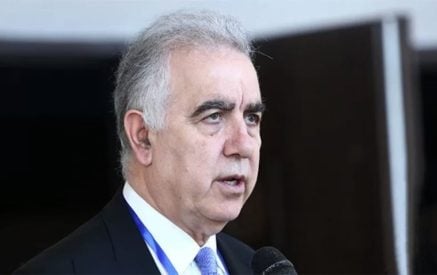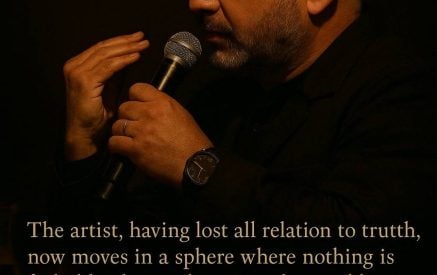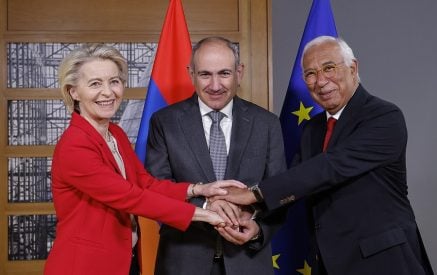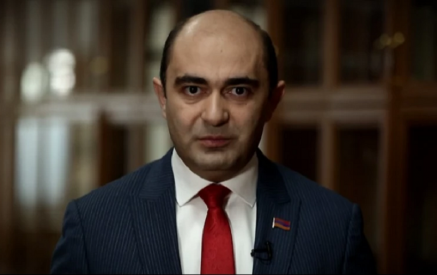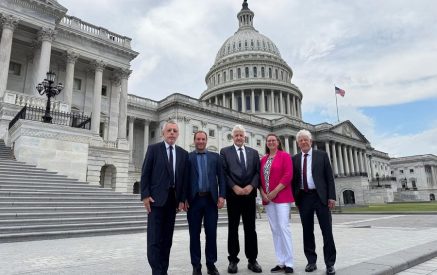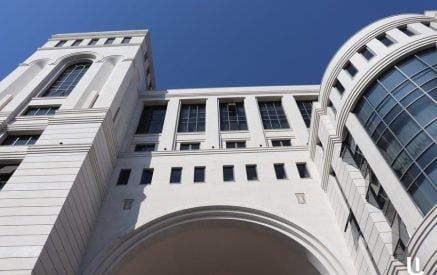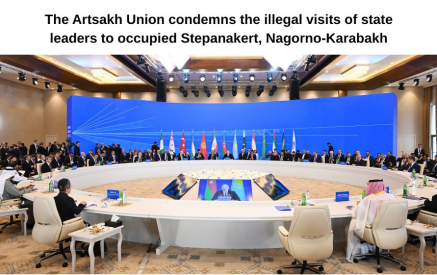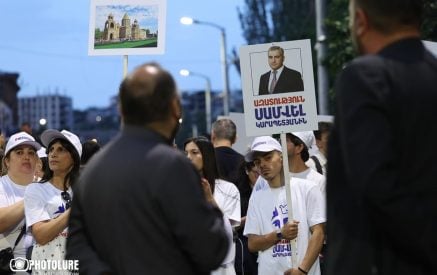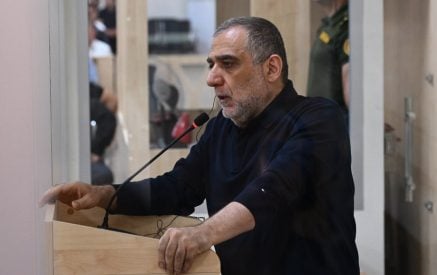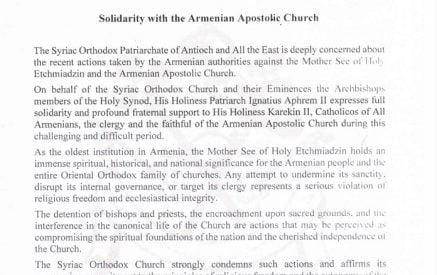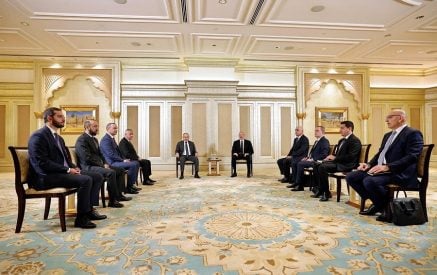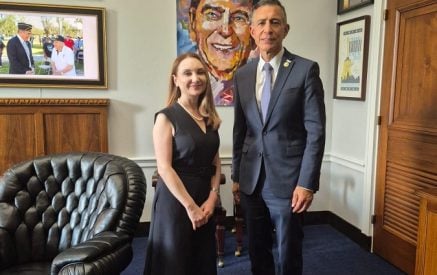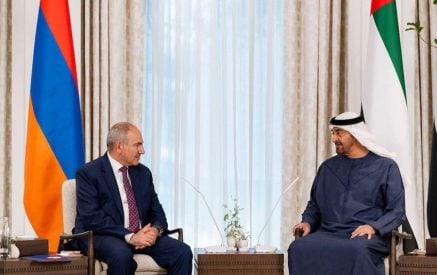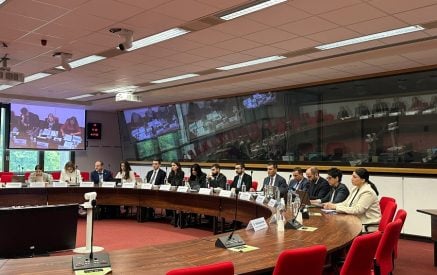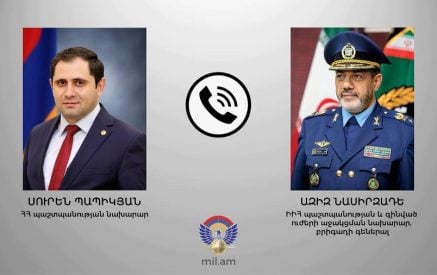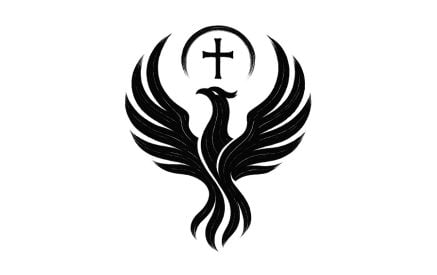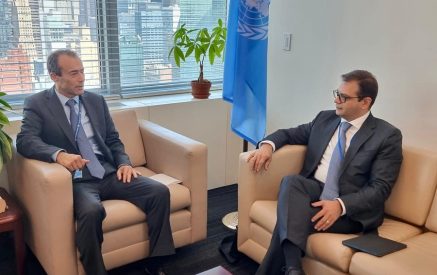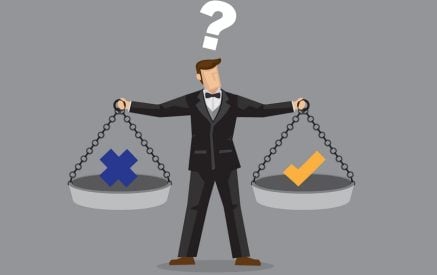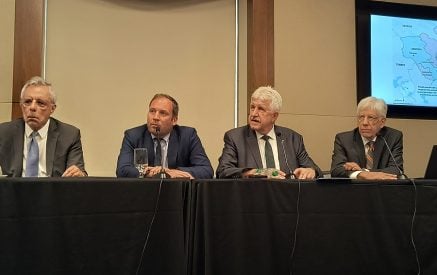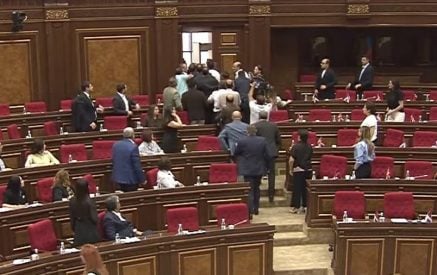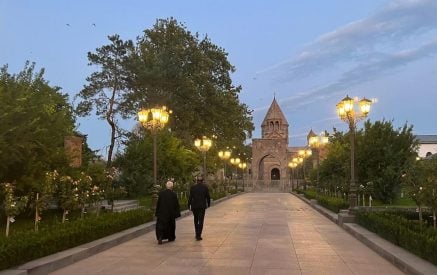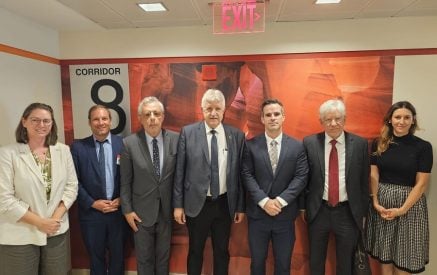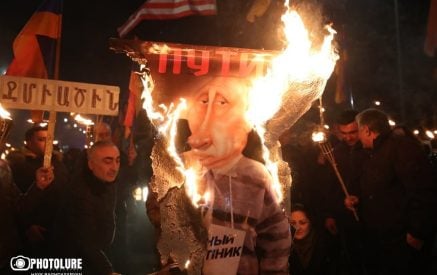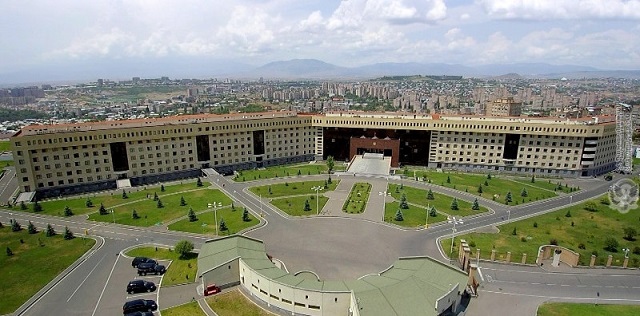Karena Avedissian, Ph.D.
with editorial assistance from Andranik Shirinyan, Sona Mkhitaryan, Roza Melkumyan, and Aimee Chen
Executive Summary
Read also
False and misleading claims have been a problem in Armenia’s information space in the past. However, with the onset of COVID-19 and the Nagorno-Karabakh 44-Day War in 2020, the country is more vulnerable to disinformation than ever before. While the Government of Armenia has acknowledged the threat that disinformation poses to its democratic system and has taken some positive measures to address it, its response has been overall insufficient to address the long-term, complex challenge that disinformation presents. The unimpeded spread of disinformation is particularly concerning for Armenia’s fragile process of democratic development as well as its resilience as a state given its ongoing national security issues. This policy brief analyzes international best practices for combating disinformation and offers recommendations to the government on how to combat disinformation more effectively.
Introduction
The danger that disinformation poses to public life in Armenia has significantly increased since the 2020 Nagorno-Karabakh War, with a fragile peace process and quickly evolving national security threats – all while the country struggles with competing visions for its future.
Disinformation campaigns present a greater risk to fragile democracies like Armenia’s, which grapple with complex historical, societal, and economic issues. Additionally, in this period of conflict management, public access to high-quality and accurate information is essential for the resilience of democratic governance. This calls for a principled approach to tackling disinformation, which protects, rather than erodes, freedom of expression, even and especially in fragile democracies facing national security threats. International best practice which has balanced the fight against disinformation with protection of freedom of speech can serve as a model.
International Best Practice
Threats posed by disinformation cannot be solved by governments alone. Increasingly, policy interventions acknowledge and account for the fact that every actor in society, down to the individual level, has a role to play in combating disinformation. The lack of clarity on the problem’s various aspects and potential solutions, together with the complex and rapidly evolving nature of disinformation, calls for a more conscious effort to facilitate collaboration across sectors and between various actors.
The European Commission highlights that effective responses to disinformation are most likely to result from multi-stakeholder collaborations.[1] To enhance state and societal resilience against disinformation, it is important to empower all actors in society to combat it. Any comprehensive disinformation strategy should follow a whole-of-society approach, where the state retains a coordinating role.[2] Critical societal functions are increasingly controlled by private actors – thus these actors must have a clear understanding of what disinformation threats entail, and what role they can play in responding and building resilience to disinformation activities.
The Armenian government’s counter-disinformation strategies have so far lacked a whole-of-society approach and have been fragmentary and corrective, rather than comprehensive and future-proofed. While the 2023 National Strategy Against Disinformation[3], which has not yet been adopted by the government, offers a framework for greater engagement between government and the private sector as well as through improving public resilience through education and media literacy, it is not as complete as the whole-of-society approach, fails to develop ways of institutionalizing a comprehensive response to disinformation, and neglects disinformation in the digital sphere.
The key principles[4] of a whole-of-society approach are:
- Multi-stakeholderism: Rejecting siloed approaches and working collaboratively, instead of competitively, across governmental departments through interagency coordination, as well as with civil society, the media, academia, and the IT sector. It also means embracing diversity in terms of social backgrounds and disciplinary expertise to anticipate new disinformation trends.
- Structural: Addressing the production of disinformation at its roots, rather than simply offering corrections. To do this, it is necessary to examine the political economy of disinformation, including how its financial flows operate, and the digital platforms through which it spreads.
- Local: Recognizing how targeted disinformation can inflict particular harm to vulnerable groups, such as ethnic minorities, women, LGBTQ+ individuals, and human rights defenders. It requires empowering those on the front lines of fighting disinformation, such as journalists, to protect themselves. This requires explicit co-ownership of information security by a variety of players across government, civil society, and the private sector.
A Legal and Regulatory Framework
Effective legislation can create an environment more conducive to countering disinformation. In particular, the right regulatory framework can ensure: 1) the alignment of new policies with the whole-of-society approach; 2) the establishment of the mission and operation, as well as the rights and obligations, of a new public authority tasked with identifying and countering disinformation; 3) the institutionalization of the various concepts related to disinformation; 4) establish effective policies for countering disinformation in the digital sphere and in particular on social media. These should include the development of robust content policies and the outlining of clear guidelines for identifying and removing false or misleading information from platforms. To ensure its effectiveness, such legislation should incorporate input from media associations, the tech sector, civil society, and international organizations. This collaboration from different sectors is especially important given that the government is currently working on significant media reforms which include the consideration of additional self-regulatory frameworks and sanctions on outlets that spread mis- or disinformation.
A New Public Authority
When devising a strategy to combat disinformation, the question that always arises is who is responsible for fighting it. According to the Organization for Economic Cooperation and Development (OECD), 64 percent of surveyed governments indicated that they had specific structures, teams, or individuals responsible for countering disinformation.[5] This represents a trend towards the creation of new bodies, agencies, or teams with authority to combat disinformation.
These bodies are responsible for different aspects of combating disinformation, from identifying disinformation and assessing threat levels to advising on responses. A degree of centralization of such an authority can help build expertise and capacity while simultaneously putting it to the service of other parts of government, but its duty should be to collaborate across ministries and departments, and with non-governmental actors. Armenia does not yet have such a body, but it does have the Public Relations and Information Center, which is a natural candidate for assuming responsibility for counter-disinformation activities as it already formulates government communication, analyzes information security, and develops legislation around the mass media. Its activities, however, do not include tackling disinformation.
An example of an entity that does tackle disinformation is the United Kingdom’s Rapid Response Unit (RRU), a centralized agency in the Cabinet Office that monitors media and online content for the whole of government and uses software to track online narratives in online discourse in real time. If the Rapid Response Unit (RRU) identifies disinformation that is gaining traction, it will bring it to the attention of the relevant governmental department, which can then take action if deemed necessary.[6] Similarly, the Swedish Psychological Defence Agency,[7] which was established to identify, analyze and respond to disinformation directed at Sweden or Swedish interests, helps coordinate the activities of various agencies and other actors.[8]
Ensuring that rights are not violated can be integrated into the body’s structure and operations. France’s Viginium, a department within the Secretariat-General for National Defence and Security, exemplifies a separation of powers model. The department’s purpose is to identify foreign interventions and bots spreading politically destabilizing content. However, to ensure freedom of speech, it separates the responsibility for identifying disinformation sources and attacks from the execution of a response. For example, during the 2022 French elections, the unit identified five foreign interference attempts and referred them to other parts of government to decide whether and how to act.
Conceptual Clarity
To strengthen the policy and regulatory framework, the government must also introduce clear legal definitions of disinformation and its related terms into the national legal framework. These definitions should derive from those recognized and observed at the international level.
Defence Research and Development Canada cites scholars’ and practitioners’ emphasis on the importance of agreeing on a taxonomy of disinformation-related terms to help inform and shape policy and strategy.[9] How to cultivate a suitable response to an information threat would depend on whether the threat is mal-, mis-, or disinformation, foreign interference, or a hybrid threat. In Armenia, no official document provides distinct definitions for the term “disinformation” or its related phenomena, and official government communication often conflates the term with “misinformation” or even calls it “fake news”[10] in various communications.
Formalizing and adopting official definitions and using terms consistently across official materials can help states move from fragmentary methods to more systematic, institutionalized approaches. The OECD has drawn on the following definitions of three of the main issues commonly conflated with disinformation:[11]
| Misinformation: when false information is shared, no harm is intended. This typically consists of rumor or misleading content shared unknowingly by individuals. |
| Disinformation: when false information is knowingly shared to cause harm. Disinformation can often be traced back to actors with malicious motives and can be part of concerted large-scale campaigns. |
| Malinformation: when genuine information is shared to cause harm, often by moving what was designed to stay private into the public sphere. |
Defining the problems and scope of interventions provides clear guidance on objectives, roles, and responsibilities. This can help build and consolidate responses to information disorder. Given the cross-cutting and multi-disciplinary nature of the challenge, it can be helpful to have formal guiding documents that cover all aspects of the response, such as platform governance, communication, and media and information literacy.
Social Media
Social media has been found to amplify emotional and polarizing content, including disinformation.[12] There are important regulatory considerations related to strengthening transparency around social media company operations and the data they hold. In Armenia, social media is one of the primary sources of disinformation.[13] Although the country has made some steps towards addressing cyber- and digital security issues, they are insufficient and partial strategies for digital and information security.
While social media platforms often say they will abide by local laws, they do not always comply with country requests for geo-blocking or content removal. Still, governments have tools which they can use to exert pressure on platforms to restrict certain content in their jurisdiction, and which have been shown to demonstrate their leverage over platform companies.[14] However, this authority carries with it the danger of infringement of free speech.
Empirical research identifies several practical responses to disinformation that have been successful without infringing on free expression or other fundamental rights.[15] In terms of legal responses, it is important that the same standards of rights protections and enforcement of restrictions apply to online content as well as offline. Protecting free speech while countering disinformation requires that any legal restrictions on speech are clearly and specifically prescribed by law and only introduced to protect other fundamental values and are proportional to the threat at hand. These three conditions are outlined in the European Convention on Human Rights.[16] Examples of practical responses include France’s adoption of a law in 2018 that made algorithms more transparent, making audiences more aware of online information.[17] Additionally, Spain introduced a regulation in 2020 allowing government bodies to monitor the information space, issue warnings, and launch counter-disinformation campaigns.[18]
Effective Communication Strategy
Providing timely and accurate information is a fundamental function of government. It plays a crucial role in helping governments respond to disinformation. By institutionalizing robust responses, governments can contribute to a healthy information environment. Good public communication can preempt disinformation, fill informational vacuums, and strengthen institutional trust. However, it must be perceived as a two-way engagement with citizens. The Armenian government has thus far failed to implement an effective strategy for countering disinformation, contributing to the vulnerability of Armenia’s information space, creating informational vacuums, and exacerbating societal divisions.
To combat disinformation, governments, traditional media, fact-checkers, technology companies, civil society, and citizens must all collaborate to promote trustworthy content and strengthen the information environment. The OECD has developed Good Practice Principles for Public Communication Responses to Mis- and Disinformation to guide cross-sector efforts.[19] Based on effective practices from various countries, these principles focus on strengthening the flow of information and engagement between the government and civil society partners.
Overview of the Good Practice Principles:
| 1. Institutionalization
Governments should consolidate interventions into coherent approaches guided by official policies, standards, and guidelines. Public communication offices will benefit from adequate resources, a well-coordinated approach at all levels, and professional staff |
2. Public interest driven
Public communication should be independent from politics when countering mis- and disinformation. It should be distinct from partisan and electoral communication, and include measures for clear authorship, impartiality, accountability, and objectivity |
3. Future-proofing & professionalization
Public institutions should invest in innovative research and strategic foresight to prepare for threats in technology and information ecosystems. Interventions should be open and adaptable, and efforts to professionalize capacity to respond to evolving challenges should be matched |
| 4. Transparency
Governments should communicate transparently, disclosing information and decisions, within legal limits. Transparency reduces rumors, allows public scrutiny, and promotes honesty and clarity in decision-making. |
5. Timeliness
Public institutions must quickly identify and respond to emerging narratives and false information, given the speed at which it can spread. Communicators can prepare by creating mechanisms for quick intervention with accurate and compelling content. |
6. Prevention
Governments should prevent the spread of mis- and disinformation by identifying and monitoring problematic content and its sources, proactively filling information gaps, anticipating disinformation tactics and taking appropriate action such as “pre-bunking.” |
| 7. Evidence-based
Government interventions should be informed by reliable data, testing, and audience insights. Research and analysis should continuously feed into improved practices. Governments should recognize emerging narratives, behaviors, and characteristics to understand the context in which they are communicating and responding. |
8. Inclusiveness
Interventions should be diverse and inclusive to cover all groups in society. Official information should be relevant and easily understood, with messages tailored for diverse audiences. Communication should reach disengaged, underrepresented, or marginalized groups. Adequate resources and dedicated efforts can facilitate two-way dialogue to counteract disinformation. |
9. Whole-of-society
Governments should work with stakeholders such as the media, private sector, civil society, academics, and individuals to counter disinformation. This includes promoting public resilience and creating an environment that encourages constructive engagement with information. Public institutions should coordinate and build trust with non-governmental partners across the country. |
Measures Taken to Counter Disinformation in Armenia
Armenian civil society has been part of anti-disinformation efforts through initiatives that strengthen independent media,[20] achieve transparency in media ownership and financing, promote self-regulation mechanisms for the media, establish fact-checking programs, and provide media literacy education. These measures have been critical for enhancing media literacy and increasing the transparency, accountability, and trustworthiness of the media. However, civil society, particularly rights defenders, can improve their efficacy by viewing communication of information as a tool for a long-term and cohesive strategy for retaking control over broader narratives and reshaping the public’s understanding of human rights.
The Armenian government has begun paying more attention to the threat of disinformation and taking some measures to counter it, even as its approach has been fragmented, unskillful, and lacking in strategic or comprehensive thinking. The country’s current National Strategy[21], adopted in 2020, identified cyberattacks by foreign states, individuals, and other organizations as threats to information security. It also acknowledged that various disinformation tools are becoming more frequent and are targeting democratic values. The strategy pledged to develop national information and cyber capabilities, but so far, there has been little progress.
The Armenian National Assembly has made some progress in legislating to fight disinformation. In 2020, it mandated ethics codes and self-regulation mechanisms for broadcasting outlets participating in licensing competitions, although the extent of enforcement is still unclear.[22] Additionally, in 2020, the National Assembly passed the Law on Audiovisual Media, which requires greater reporting and financial transparency from broadcast outlets. Despite this effort to improve transparency in TV ownership in the country, available information on who controls various media remains opaque, and broadcast outlets’ connections to political parties are often revealed through investigative reporting.
Some Armenian lawmakers’ attempts to legislate against disinformation, particularly those that made changes to the criminal code, have been criticized by media groups for their potential to be indiscriminately used against legitimate free speech.[23] One proposed bill would prohibit journalists from using unidentifiable online sources, severely limiting their ability to use information from social media. The bill was only changed after pressure from the media community. Other bills appeared to be aimed at controlling the portrayal of public officials in the news rather than fighting disinformation.[24] Additionally, proposed legislation overall has not addressed the rapidly evolving threat of disinformation and has not taken a more comprehensive approach.
Disinformation in Armenia has, to a large extent, targeted vulnerable groups, including the LGBTQ+ community, women’s rights activists, and human rights defenders. However, the government has made very little effort to include representatives from these communities in policy development around disinformation. Information security is a crucial part of national defense and should be co-owned by a variety of players.[25] The lack of participation from vulnerable groups in policymaking to counter disinformation highlights the government’s disregard for a whole-of-society approach and its inability to build nationwide resilience against disinformation in the country. This failure to acknowledge the unique impacts of disinformation on various vulnerable communities also exacerbates the problem. Including these groups in policymaking is essential to achieving more effective and accountable policies.
The Freedom of Information Center of Armenia has developed a National Strategy Against Disinformation to ensure the government can prevent, detect, and analyze disinformation. This is the most comprehensive framework for combating disinformation developed in partnership with the government. The strategy outlines several thematic focuses for recommendations, including strengthening Armenian institutions’ capacity to respond to disinformation, improving cooperation with the private sector, and building on media literacy. While the recommendations are a good step forward, some problems remain with the framework. In particular, it lacks both a compelling rationale and a comprehensive plan to institutionalize and systematize a counter disinformation strategy. The strategy further neglects the unique threat of disinformation to digital media and fails to address the distinct threats of misinformation and malinformation.
Recommendations
Whole-of-Society Approach
Countering disinformation in Armenia is not solely the responsibility of the government. A whole-of-society approach, coordinated by the government and reflecting the critical role of civil society, journalists, and the private sector, is necessary. Given the reality of underfunded and piecemeal approaches to countering disinformation in Armenia, the government must share functionality with non-governmental actors. A comprehensive understanding of available tools across the spectrum of actors and functions is key to a coordinated impact, as is identifying mutually beneficial roles. For this, the government should:
- Continue to undertake counter-disinformation activities through existing frameworks, including the adoption of the recommendations made by the 2023 National Strategy Against Disinformation, but to include clear definitions, and a plan for whole-of-society engagement.
- To work with civil society, media, and the private sector collaboratively to establish public-private partnerships to share information, resources, and strategies for combatting disinformation.
- Identify roles and functions that are available for a whole-of-society approach.
- Strengthen and expand efforts to support independent online media. This can be done through financial assistance and innovative financing models, technical support, and professional development programs. These efforts should support existing initiatives by civil society to improve media literacy.
- Develop legislation to protect the free flow of information, make officials accessible to journalists, and provide timely responses to freedom of information requests.
Legal and Regulatory Framework
Following international best practice, Armenia must establish a dedicated national authority for identifying and countering disinformation. The body would be responsible for building whole-of-government responses to disinformation across government and with civil society. It could achieve this by:
- Ensuring clear delimitations of the future public authority in preventing and combatting disinformation.
- Working with Armenia’s National Security Service to assess risks and consequences of foreign interference.
- Coordinating outreach and advising at-risk sectors and systems against foreign interference.
- Protecting free speech and rights by separating decision-making with regards to identifying disinformation from that which prescribes a response, in particular when it comes to sanctioning or other punitive measures.
- Ensuring its independence by creating it by law, mandating fixed, long-term positions for members and a high, fixed salary; a budget sufficient for the body’s responsibilities established by law; and spending and accounting for funds directly to the National Assembly.
- Ensuring participation of vulnerable groups, including journalists, rights defenders, women, and the LGBTQ community in decision-making.
- In case of limited resources, it is possible to initially focus on cooperation with civil society and exchange of information across government.
Additionally, the government should introduce and formalize clear legal definitions of misinformation, disinformation, and malinformation, as well as hybrid threats and influence campaigns into the national legal framework. The definitions of the terms should derive from those recognized and observed at the international level and should be reflected in all official materials and communications.
In terms of social media, the government should:
- Clearly enshrine in law the cooperation between national authorities and accountability of big tech companies in Armenia.
- Support independent fact-checking initiatives that work to verify the accuracy of information circulating on social media and provide clear and reliable debunking of false claims; it should also make efforts to provide timely responses to fact-checking organizations’ queries in confirming or denying claims.
- Scale up cooperation with other countries to share best practices, exchange information, and coordinate efforts to combat transnational, digital disinformation campaigns.
Efficient Communication Strategy
It is critical that the Armenian government, together with civil society, devise a coherent, comprehensive, and proactive communication strategy to improve the health of the information space. This will also make substantial strides in promoting governmental transparency, building trust in state institutions, and ultimately – increasing Armenia’s democratic resilience. The strategy should embody the OECD’s Good Practice Principles:
- Institutionalization
- Public interest driven
- Future-proofing and professionalization
- Transparency
- Timeliness
- Prevention
- Evidence-based
- Inclusiveness
- Whole-of-society collaboration
___________________________________
Karena Avedissian, PhD is a political scientist and expert on state-society relations, strategic narratives, and political communication in Eurasia. She received her PhD from the Centre for Russian and East European Studies at the University of Birmingham in 2015. Since then, she has worked as research fellow at the University of Southern California and the University of Birmingham researching Armenian state building and Russian disinformation campaigns. She cooperates with the University of Götenburg’s V-Dem Institute, and her work on the interplay of authoritarianism, societal vulnerabilities, and civil society has been published in academic publications and in The Guardian. She is a Fellow of the Royal Society of Arts.
Endnotes
[1] A multi-dimensional approach to disinformation – Report of the Independent High Level Group on Fake News and Online Disinformation, European Commission, Directorate-General for Communications Networks, Content and Technology, Publications Office,
[2] Disinformation in Democracies: Improving Societal Resilience to Disinformation, NATO Strategic Communications Centre of Excellence, https://stratcomcoe.org/pdfjs/?file=/publications/download/Disinformation-in-Democracies-DIGITAL.pdf?zoom=page-fit
[3] The strategy, developed by Armenia’s Freedom of Information NGO, offers a framework for countering disinformation and is being considered for adoption by Armenia’s government. The document can be found here: http://www.foi.am/hy/research/item/2265/
[4] Ong, Jonathan Corpus “Mitigating Disinformation: Towards a Whole of Society Approach”, April 21, 2021, https://fight-dis.info/Mitigating-Disinformation-Towards-a-Whole-of-Society-Approach.html
[5] Good practice principles for public communication responses to mis- and disinformation, OECD Public Governance Policy Papers,
[6] Rapid Response Unit, UK Parliament, https://questions-statements.parliament.uk/written-questions/detail/2023-02-20/148802
[7] Swedish Psychological Defence Agency, https://www.government.se/government-agencies/swedish-psychological-defence-agency/
[8] The agency began its operations on January 1, 2022, and reports to the Swedish Ministry of Justice.
[9] RESIST 2 Counter Disinformation Toolkit, UK Government Communication Service,
https://gcs.civilservice.gov.uk/publications/resist-2-counter-disinformation-toolkit/
[10] The term “fake news” does not have an agreed upon definition and is not commonly used among disinformation experts.
[11] These definitions are not exhaustive. It is also recommended to supply definitions for related terms like “hybrid threats” and “malign foreign influence campaigns” which pose no less of a threat to Armenia than disinformation.
[12] Robert Elliott Smith, “Rage Inside the Machine: The Prejudice of Algorithms, and How to Stop the Internet Making Bigots of Us All”
[13] Disinformation in Armenia, Freedom House, https://freedomhouse.org/sites/default/files/2021-06/Disinformation-in-Armenia_En-v3.pdf
[14] Rasmus Kleis Nielsen, “How to respond to disinformation while protecting free speech”, February 19, 2021, https://reutersinstitute.politics.ox.ac.uk/news/how-respond-disinformation-while-protecting-free-speech for examples of Vietnam and Turkey.
[15] Examples include recommendations identified by the 2017 UN IGF Dynamic Coalition on Platform Responsibility (DCPR). See Platform regulations: how platforms are regulated and how they regulate us,
http://bibliotecadigital.fgv.br/dspace/handle/10438/19402
[16] Dominika Bychawska-Siniarska, “Protecting The Right To Freedom Of Expression Under The European Convention On Human Rights”, https://rm.coe.int/handbook-freedom-of-expression-eng/1680732814
[17] LOI No 2018-1202 du 22 décembre 2018 relative à la lutte contre la manipulation de l’information.
[18] Orden PCM/1030/2020, de 30 de octubre, por la que se publica el Procedimiento de actuación contra la desinformación aprobado por el Consejo de Seguridad Nacional.
[19] Good practice principles for public communication responses to mis- and disinformation, OECD Public Governance Policy Papers,
[20] This most notably includes the Yerevan Press Club’s Media Ethics Observatory, a self-regulation body that unites more than 60 media outlets as signatories to their professional code.
[21] National Security Strategy of the Republic of Armenia, https://www.mfa.am/filemanager/security%20and%20defense/Armenia%202020%20National%20Security%20Strategy.pdf
[22] Arshaluys Barseghyan, Lusine Grigoryan, Anna Pambukhchyan, Artur Papyan, “Disinformation and Misinformation in Armenia” Freedom House, June 3, 2021, https://freedomhouse.org/sites/default/files/2021-06/Disinformation-in-Armenia_En-v3.pdf
[23] Ibid.
[24] These include two bills proposed by Alen Simonyan which triple the financial penalty for defamation or insult and which impose strict penalties for deliberately spreading false information or defamation under a pseudonym, respectively. Seda Ghukasyan, “Kreakan pataskhanatvutiun keghts teghekutiunneri, viravoranki yev zrpartutian hamar. Alen Simonyani nakhagitsy, March 27, 2021, https://hetq.am/hy/article/129049
[25] Dmitri Teperik, Solvita Denisa-Liepniece, Kaare; Kullamaa, “Resilience Against Disinformation A New Baltic Way to Follow?” International Centre for Defence and Security. October 2022,


